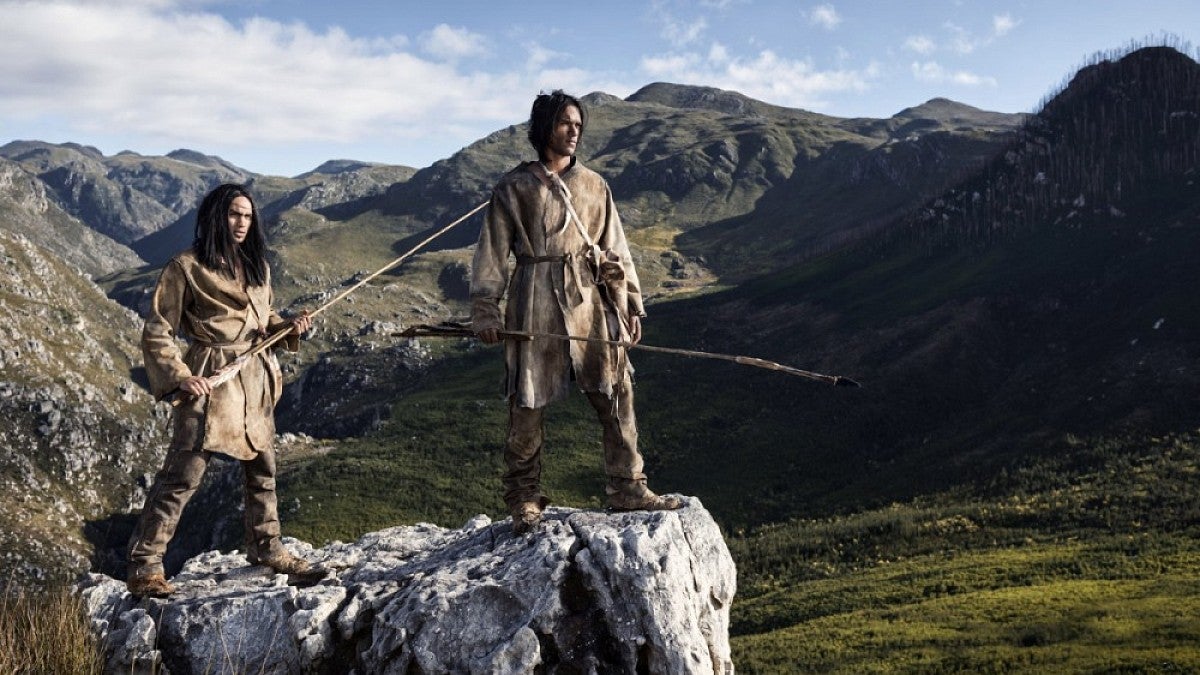When Jon Erlandson agreed to appear in the premiere episode of FIRST PEOPLES, a new PBS series that traces the earliest evidence of Homo sapiens around the globe, he didn’t realize what he was getting himself into.
Filmed partly on location at Port Orford, the episode, which airs on Oregon Public Broadcasting at 9 p.m. Pacific Time on Wednesday, June 24, includes footage of the University of Oregon archaeologist kayaking the windy Pacific Ocean waters off the southern Oregon Coast.
“I think I was in the water for a total of eight hours that day,” Erlandson said. “I stayed warm enough while paddling, but by day’s end, I was so exhausted I had the film crew tow me back in to shore. By the time I got there, I was stone-cold shivering. I felt like I was on the verge of hypothermia.”
FIRST PEOPLES examines the deep human past in Africa, Asia, Australia and Europe, but its first episode focuses on the peopling of the Americas and growing evidence that the first Americans may have arrived by boat, rather than on foot as it has long been thought.
That’s where Erlandson comes in.
A Phillip H. Knight Professor of anthropology and executive director of the UO Museum of Natural and Cultural History, Erlandson is an internationally recognized authority on the archaeology of seafaring and coastal cultures. He's also part of a new wave of coastal migration theorists who are challenging long-accepted ideas about how and when people first arrived in North America.
For much of the 20th century, the story of the first Americans focused on the idea that big-game hunters followed their prey from Siberia to Beringia, and south to the Great Plains, via a narrow land corridor that opened as two vast Canadian ice sheets retreated.
Based on his work at sites on California’s Channel Islands and elsewhere on the Pacific Coast, Erlandson offers a different scenario in which the first Americans arrived by way of extensive kelp-forest ecosystems spanning the Pacific Rim.
“The kelp highway would have facilitated human migration along a coastal route from Asia to the Americas,” he said. “Teeming with food resources and offering holdfasts and protection from wave energy, it would have made for a relatively rapid and unobstructed journey to North America.”
Erlandson said that very similar ecosystems of seaweeds, fish, marine mammals and birds are found today over broad stretches of the North Pacific Rim, from northern Japan to Baja California.
While terrestrial models assert that people spread into coastal areas only after inland game herds were depleted, Erlandson and other coastal migration theorists suspect that a reverse pattern played out.
“The kelp highway hypothesis doesn’t assert a headlong rush along the ancient coastline,” Erlandson said. “Rather, seafaring people were likely exploring and settling along major rivers as well, which acted as corridors into the interior.”
Such welcoming waterways may have carried them to the extensive wetlands of the Northern Great Basin, a region that straddles southeastern Oregon, southern Idaho and northern Nevada.
Scientists with the Museum of Natural and Cultural History have made groundbreaking discoveries in the Northern Great Basin since the 1930s, when museum director Luther Cressman uncovered 10,000-year-old sandals from Oregon’s Fort Rock Cave. Since then, the region’s caves and rock shelters have produced additional discoveries that both broaden and redefine theories about human settlement in the Americas.
In 2002, UO archaeologist Dennis Jenkins uncovered 14,000-year-old human feces at Paisley Caves in south central Oregon. The dessicated specimens, known as coprolites, represent the oldest human remains in the Western Hemisphere. Together with bison and other animal bones uncovered at the site, they reveal a human occupation that predates the Clovis tradition — long regarded as the oldest cultural tradition in the Americas — by 1,000 years.
Jenkins, who directs the annual UO archaeology field school, said he is looking forward to an exciting season this year. “I will be leading a field school session at Connley Caves in the Fort Rock Basin this summer, where we’ve been investigating the human responses to a changing paleoclimate.”
Erlandson will return to California’s Channel Islands, continuing his search for some of the Pacific Coast’s earliest human inhabitants.
—By Kristin Strommer, Museum of Natural and Cultural History


